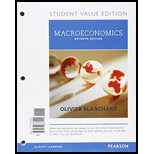
Macroeconomics, Student Value Edition Plus MyLab Economics with Pearson eText -- Access Card Package (7th Edition)
7th Edition
ISBN: 9780134472669
Author: Blanchard
Publisher: PEARSON
expand_more
expand_more
format_list_bulleted
Question
Chapter 16, Problem 5QAP
a
To determine
To show:Impact on current output, interest rate, current private spending when FED will not change its current real policy interest rate.
b
To determine
To know:Impact on current output, interest rate, current private spending when FED will act to prevent change in current and future output.
c
To determine
To Know:Impact on current output, interest rate, current private spending when FED will not change either current real policy interest rate or the future real policy.
Expert Solution & Answer
Want to see the full answer?
Check out a sample textbook solution
Students have asked these similar questions
Topic Discussion - If you are a dís X
ses/1545/discussion_topics/15678?module_item_id=111458
er > Discussions > Discussion - If you are a distrib...
You must post before seeing replies. Edit history will be available to instructors.
Due Dec 21 11:59pm
10 points possible
32 Replies, 32 Unread
Discussion - If you are a distributer of Gerber, how do you promote selling
our product?
equirement:
Include Introduction, Body, and Conclusion.
Your initial Discussion posting should be at least 150 words in length.
Be sure to include a related Title, at least two different citations and references to support your statement
Read and post brief responses to at least two of your classmates' postings (minimum 75 words).
Not use ai please
Q Search entries or author... All
↓ Sort
View Split Screen
Expand Threads
i
You must post before seeing replies. Edit history will be available to instructors.
Due Dec 21 11:59pm
10 points poss
18 Replies, 18 Unread
Discussion 15: Organizational Structures
Select one of the questions below and write a 150 - 200 word discussion post. Respond to at least one other student in 50 - 100
words.
1. Describe the characteristics of a bureaucracy.
2. Describe a matrix organization.
Q Search
hp
Chapter 16 Solutions
Macroeconomics, Student Value Edition Plus MyLab Economics with Pearson eText -- Access Card Package (7th Edition)
Knowledge Booster
Similar questions
- Q Search entries or author... All i ↓ Sort View Split Screen Expand Threads You must post before seeing replies. Edit history will be available to instructors. Due Dec 21 11:59pm 10 points pos 19 Replies, 19 Unread Discussion 14: Conflict Write a 150-200 word discussion post based on the 3 prompts below. Respond to at least one other student in 50 - 100 words 1. Define conflict. 2. Contrast task, relationship, and process conflict. 3. Explain contemporary perspectives of conflict. Reply Q Searcharrow_forwardX Topic: Discussion 12: Leadership X /courses/1548/discussion_topics/15744?module_item_id=111746 Winter > Discussions > Discussion 12: Leadership You must post before seeing replies. Edit history will be available to instructors. Due Dec 14 11:59pm 时☆ 10 points possible 18 Replies, 18 Unread Discussion 12: Leadership Select one of the questions below and write a 150 - 200 word discussion post. Respond to at least one other student in 50 - 100 words. 1. Define the characteristics of a charismatic leader. 2. Contrast transformational with transactional leaders. Reply Search X 4 b 12/arrow_forwardDon't used Ai solutionarrow_forward
- The preferences of a consumer are represented by the following utility function: U = min (×1, 2x2) If income is 100 and p1=p2=1 a) What is the optimal bundle? b) If p₁=4, what is the new optimal bundle? c) If p2=4, what is the new optimal bundle? d) Decompose the price effect into income and substitution effect and provide a graphical representation of your results.arrow_forwardChallenges of Nepal's foreign trade.arrow_forwardSolarrow_forward
- The answer is not Carrow_forwardSocial capital includes: a) labour, produced capital, and natural capital. b) human capital, physical capital, and natural resources. c) labour, physical capital, and human capital. d) labour, physical capital, and produced capital.arrow_forwardGeneral Accounting Question solution and give me Blank ? Carrow_forward
arrow_back_ios
SEE MORE QUESTIONS
arrow_forward_ios
Recommended textbooks for you
 Economics (MindTap Course List)EconomicsISBN:9781337617383Author:Roger A. ArnoldPublisher:Cengage Learning
Economics (MindTap Course List)EconomicsISBN:9781337617383Author:Roger A. ArnoldPublisher:Cengage Learning


Economics (MindTap Course List)
Economics
ISBN:9781337617383
Author:Roger A. Arnold
Publisher:Cengage Learning

